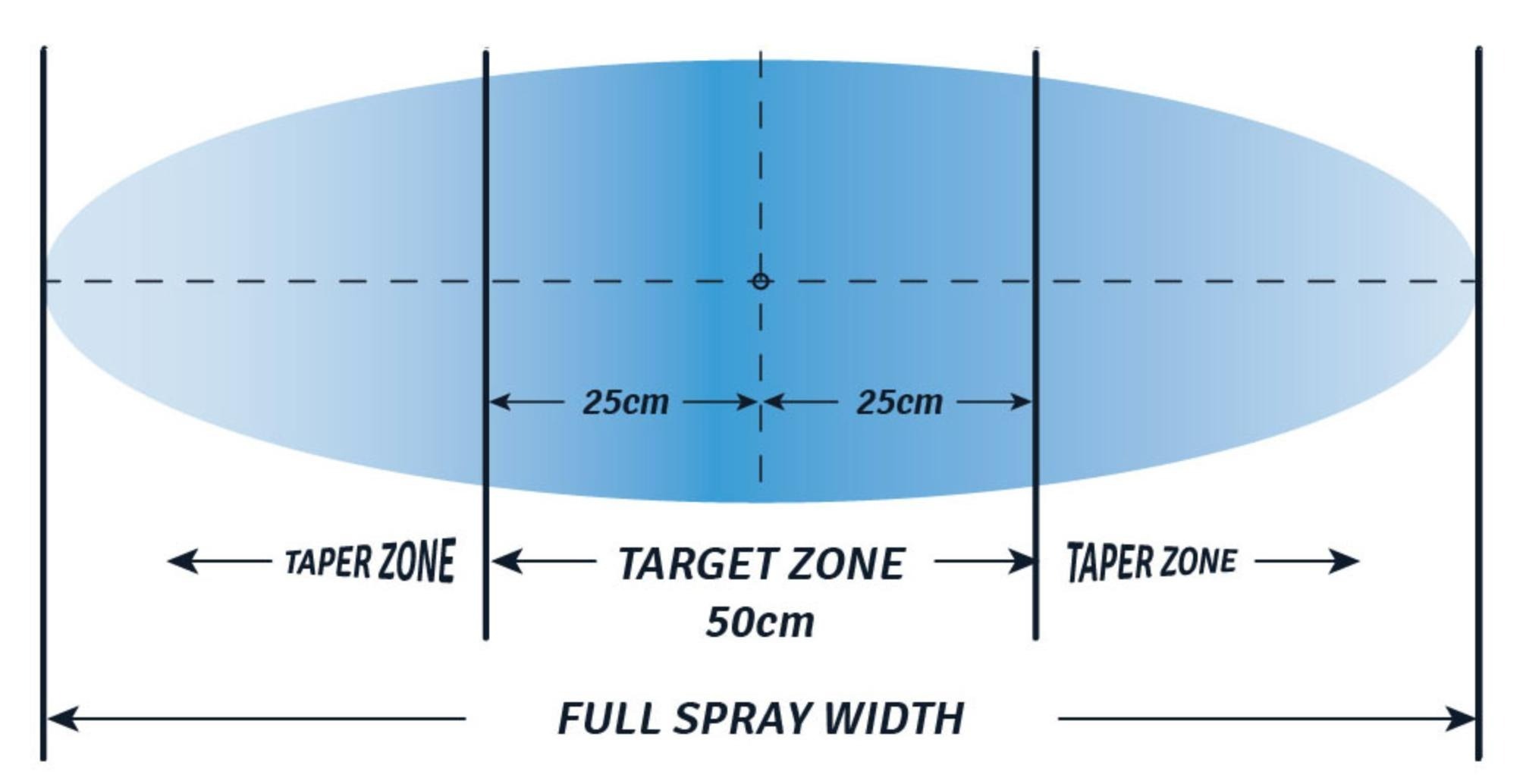OSST label rate compliance
Q&A with Gary Dorr of the APVMA on rate calculation and nozzle selection for Optical Spot Spray Technologies (OSST)
A quick look at what the target zone is. We are now applying this method to 80° nozzles in single-spot operations.

OFFICIAL
Hi David
Thanks for the email and question, it does all get a bit complicated.
I would consider calibrating the sprayer to spray the equivalent of 100 L/ha to be what would happen if you were to spray a full field. For example, if spraying a very weedy paddock where all nozzles were on all the time. This would be the same as 100 L/ha in your target zone where the target zone is 50 cm and nozzle spacing is 50 cm.
Dave: Calculating for single-spot, that is problematic as the nozzles need to be much larger to deliver 100 l/ha in isolation (say 06 instead of 04) and the rate would be way above 100 l/ha at 3 BAR operating pressure.
It would be better to calibrate the equivalent of 100 L/ha on the target zone and have the full spray width a lower rate. In most situations if a weed was in the taper zone it would also trigger the nozzle to the other side as well since it would then be in its target zone, which would give a higher rate than just the single nozzle.
Dave: Agree
It would be a concern to us if, as you describe, over 50% higher rate is being delivered in the target zone, particularly as the rate for optical spot sprayers is typically already higher, often 3 times higher, than a full field application. Hence spraying a 30% weed cover with OSST applies the same amount of chemical to a field as a standard boom spraying the full field.
For example, the rate for optical spot sprayers with Nufarm Amicide Advance 700 Herbicide is 4.8 L/ha (4.8 L/100 L spraying the equivalent of 100 L/ha) compared to a full field rate for fallow of 1.5 L/ha. If you then further increase it by 50% it would mean that, in the area where the weed is being sprayed, you are putting on the equivalent of 7.2 L/ha on your target weed compared to 1.5 L/ha on that same weed if using a standard full field boom application.
Dave: Agree that would be the case when calibrating for a single nozzle in isolation on the basis of a measured spray width, which is the usual way to do it.
Sprayers101 - Spray Patterns for Spot Sprays
In this article Tom Wolf acknowledges the bell shaped pattern and goes on to suggest that it is mitigated by a vortex effect that tends to even things out. Why we refer to Bill Gordons instructions for spray width determination in the GRDC spray notes. See page 14 at this document.
Also why we provide those instructions and require a disclaimer to be agreed to in our Apps.
This will become even more of an issue if the same approach is used for green-on-green spot spraying in the future, where these higher amounts of chemical applied in the target zone will create residues concerns.
I have not been able to get a clear reason why the rate for OSST on the target needs to be so much higher than the full field rate. Is it to account for poor targeting? There could be some argument that when using OSST the weeds may be more advanced therefore a higher rate is required?
If OSST were able to operate such that the applied chemical rate in the target zone is the same as the field rate, there would be no regulatory concern with their use. For example, if the OSST sprayed 10 % of a field and this meant that only 10% of the chemical was used compared to spraying the full field.
I would consider that choosing the smaller nozzle calibrated for the target zone and limiting the total amount of product applied so the correct rates were being applied to the target is actually following the label.
Dave: I agree on that point with the caveat, that to arrive at the Target Zone Rate depends firstly upon physically measuring the volume distribution of the nozzles, which so far as I can establish (apart from Agrifac bench testing Wilger 80° nozzles and Bill Gordon doing in field measurements with XR80's for McIntosh), is a new way of doing things.
Hope this helps a bit and not confuse things more. Happy to discuss further.
Dave: Thank you, please consider my comments above as further discussion. - Regards, Dave
Regards
Gary Dorr | Director, Pesticides
Registration Management
Australian Pesticides and Veterinary Medicines Authority
GPO Box 3262, SYDNEY NSW 2001, Australia
P: +61 2 6770 2326 M: +61 486 016 362
gary.dorr@apvma.gov.au | www.apvma.gov.au
Note that WeedSeeker and See & Spray Apps now display Target Zone rates.
We hope that you can apply this new information to your advantage.
As always, if any questions arise, just ring me.
Regards,
Dave
08 6102 5886

